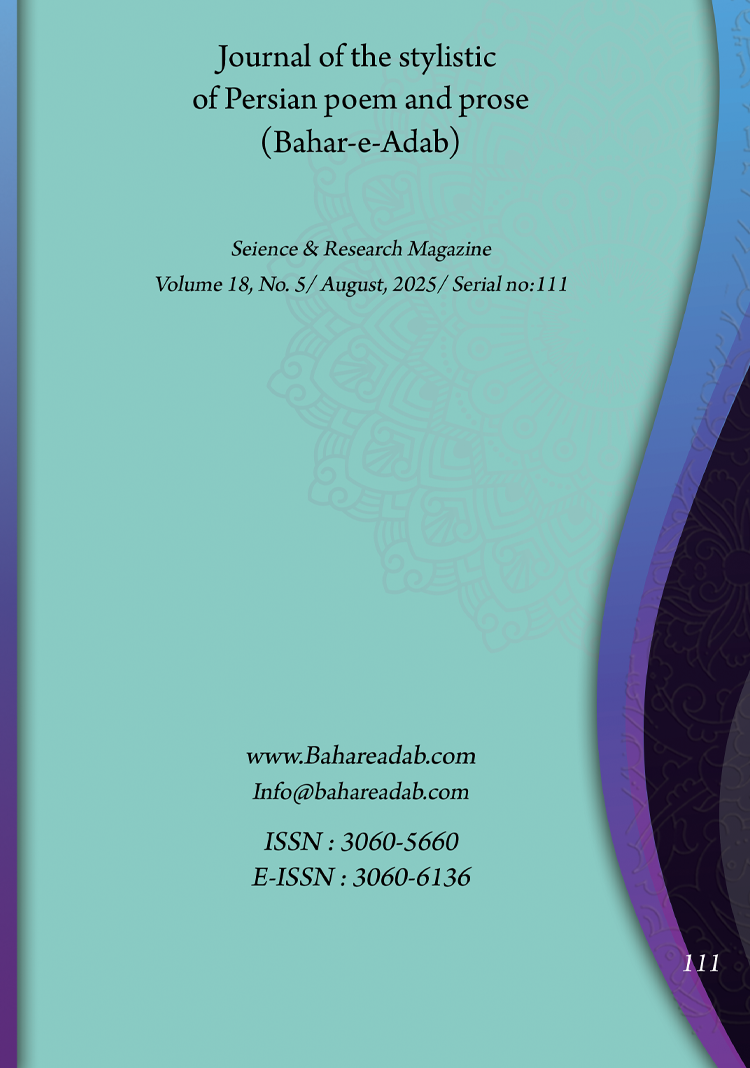- Count View : 11
- آدرس کوتاه شده مقاله: https://bahareadab.com/article_id/1859
- کد doi مقاله: Doi: 10.22034/bahareadab.2025 .18 .7887
Journal of the stylistic of Persian poem and prose
volume Number 18،
number In Volume 5،
،
issue Number 111
Comparing Women's Activism in Abu Muslim Nameh and Robin Hood
Farideh Davoudi Moghadam (Author in Charge), Motahereh Taheri
Abstract
BACKGROUND AND OBJECTIVES: Popular literature in every culture is a reflection of the ideals and anxieties of society. This study examines the representation of women"s identity and activism in two prominent works of popular literature, "Abu Muslim Nameh" (Iran) and "Robin Hood" (England). The main objective is to explore the differences in the role-playing of women in these two works.
METHODOLOGY: The method of this study is based on qualitative content analysis. The statistical population of the study is the book Robin Hood by Henry Gilbert and Abu Muslim Nameh edited by Hossein Esmaili.
FINDINGS: The women of Abu Muslim Nameh are full-fledged warriors and are capable of fighting, and spying in the battlefield. Although they are seen in the roles of lovers, daughters, sisters, and mothers; at the same time, they can also play the roles of soldiers, spies, and war commanders well. This is while the women of Robin Hood are seen only in two roles: beauties in need of help and cunning old women. The women of Abu Muslim Nameh always play a helping role, and this is seen both on the battlefield and in the court, and they play a pivotal role in advancing the narrative. While the women of Robin Hood are always helpful, and their helping role is limited to nursing, and they are mainly depicted in the position of lovers, victims, or marginal characters.
CONCLUSION: This difference can be considered a reflection of the religious context (the influence of Shiite discourse) in Abu Muslim Nameh and the feudal-patriarchal structure in Robin Hood. This study shows that popular literature is not only a mirror of social realities, but also a tool for reconstructing women"s identity in a historical context.
Keyword
Abu Muslim's letter
, Robin Hood
, Ayyari
, women.
- Abdulghani Hassan, Mohammad. (1974). Abu Muslim Khorasani (Trans. Shafiei Kadkani). Tehran: Simorgh.
- Dundes, Alan (1969). "The Devolutionary Premise in Folklore Theory". Journal of the Folklore Institute.
- Knigh Stephen.(2003). Robin Hood a mythic biography . New York .Cornell University Press.
- Pollard.A.J .(2004). Imagining Robin Hood(The Late Medieval Stories in Historical Context).London. Routledge.
- Rennison, Nick.(2012).Robin Hood: myth, history and culture. Harpenden, Herts : Pocket Essentials.-
- Sims, Martha; Martine Stephens (2005). Living Folklore. Logan, Utah: Utah State University Press.
- Tarsusi, Abu Tahir. (2001). Abu Muslim Nameh (Vols. 1-4). Tehran: Moin, Qatreh.
- Zolfaghari, H & Mahjoob, MJ. (2003). Iranian Folk Literature. Tehran: Cheshmeh Publishing.
- Sims, Martha; Martine Stephens (2005). Living Folklore. Logan, Utah: Utah State University Press.
- Dundes, Alan (1969). "The Devolutionary Premise in Folklore Theory". Journal of the Folklore Institute.
- Knigh Stephen.(2003). Robin Hood a mythic biography . New York .Cornell University Press.
- Pollard.A.J .(2004). Imagining Robin Hood(The Late Medieval Stories in Historical Context).London. Routledge.
- Rennison, Nick.(2012).Robin Hood: myth, history and culture. Harpenden, Herts : Pocket Essentials.

